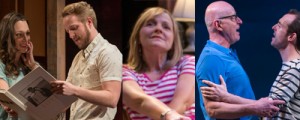![By Jeangagnon (Own work) [CC-BY-SA-3.0 (http://creativecommons.org/licenses/by-sa/3.0)], via Wikimedia Commons 450px-Love_by_Robert_Indiana_01](https://www.writerstheatre.org/blog/wp-content/uploads/450px-Love_by_Robert_Indiana_01-225x300.jpg) “Oh, well, love.
“Oh, well, love.
No wonder it’s so complicated.
These days especially.
With what we all know now
what we’ve come to know.”
– Summertime by Charles Mee
America has changed dramatically over the past 50 years, as anyone who lived through the 1960s (or who has at least caught an episode or two of Mad Men) would agree. The technology we use and the fashion trends we follow in everyday life serve as obvious indicators of the time that has passed. However, a more profound measurement of how drastically the country has shifted is in the make-up of the most fundamental social construct: family.

Only about half of American adults were married in 2008, compared to the 72% in 1960, according to a 2010 Pew Research Center nationwide survey. At a generational level, the decline is even more pronounced. In 1968, two-thirds of all twenty-somethings were married, while today that number is only 26%. Cohabitation (living together as unmarried partners) has doubled since the 1990s, with 44% of Americans saying they have cohabitated at some point in their lives. Nearly 40% believe that marriage is becoming obsolete.
Statistics on the make-up of families tells a part of the story, but attitudes towards what constitutes a family can be just as revealing. 86% of Americans consider a single parent and child a family, 80% would use the term to describe an unmarried couple with a child, and 63% feel the same way about a gay or lesbian couple raising a child. The designation of “family” is also widely bestowed on couples without children, as a childless married couple is considered a family by 88% of the public.
Fifty years ago, most Americans held a negative opinion of cohabitation without marriage, interracial marriage, and unmarried couples raising children, while today there has been a strong shift toward tolerance, with a majority now accepting of these “non-traditional couples,” regardless of whether the couple in question is straight or gay.
 America today is a place where a mere 28% of the public still believe there is “one true love” for every person. And yet our cultural tradition is made up of centuries of books, songs, poems, plays and films that subscribe to the belief of “happily ever after.” From Jane Austen to Walt Disney, from Frank Sinatra to Justin Bieber, that fantasy is reinforced again and again—the idea that a singular, all-consuming, enduring love (a heterosexual, monogamous love, of course) is out there for us all, and will lead to the twin blisses of marriage and children. The evidence, however, shows significant declines in marriage and birth rates, and a widening spectrum of relationships that fall well outside the heterosexual and monogamous.
America today is a place where a mere 28% of the public still believe there is “one true love” for every person. And yet our cultural tradition is made up of centuries of books, songs, poems, plays and films that subscribe to the belief of “happily ever after.” From Jane Austen to Walt Disney, from Frank Sinatra to Justin Bieber, that fantasy is reinforced again and again—the idea that a singular, all-consuming, enduring love (a heterosexual, monogamous love, of course) is out there for us all, and will lead to the twin blisses of marriage and children. The evidence, however, shows significant declines in marriage and birth rates, and a widening spectrum of relationships that fall well outside the heterosexual and monogamous.
While the rules of love and marriage that have been passed down by the many architects of the traditional romantic fantasy may never have had much basis in truth, more “realistic” works of art—stories about “heartbreak, rejection, pain, misery and loss,” to borrow Nick Hornby’s phrasing—proliferate, leading to unfavorable comparisons between our real lives and those unattainable magical fictions. It’s not hard to see how a troubled young adult like Tessa in Days Like Today might conclude that “love is impossible these days.”
Tessa, her mother and father and their respective lovers are all grappling with—and are sometimes paralyzed by—the inevitable gap between expectations and reality, between what they need and what they have been taught to look for.
In the absence of any true guide or template to follow, these days the only choice that seems to be left is to make up your own rules, and hope for the best.
More on Days Like Today:
Articles | Videos | Production Details | Tickets



No comments yet.